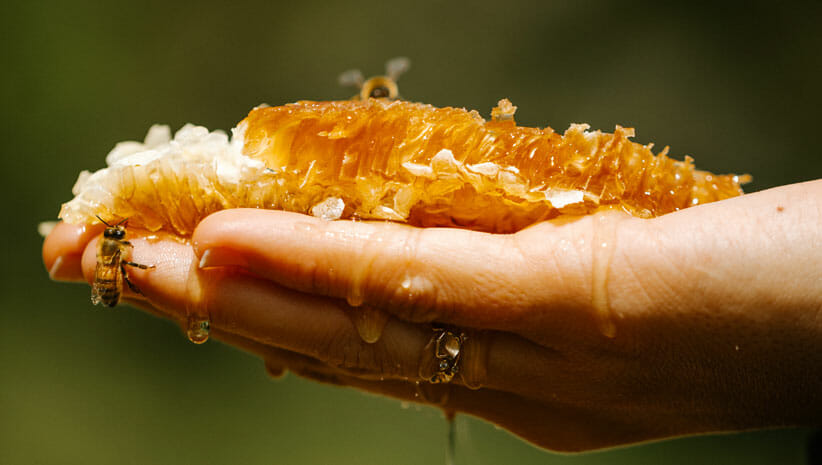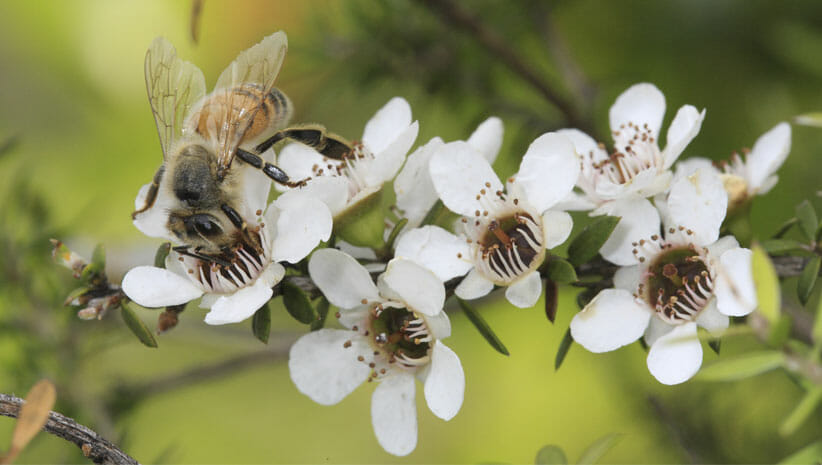
Manuka Honeycomb Photo by @elsas_wholesomelife
The first time I heard about Manuka honey, it was presented to me as an almost mythic substance. A master healer. A recommendation for something that could be eaten or used on the skin. An anti-bacterial agent. A boost for the body’s own natural healing processes. A honey beyond all ordinary honey.
Is Manuka really magic? Well, it turns out the evidence suggests this is actually true. To begin with, “Any honey is good for you,” say Les Stowell, the General Manager of Onuku Limited in New Zealand and one of the trustees of the Onuku Maori Lands Trust, which farms land that includes groves of Manuka trees. Les started out as a bit of a Manuka skeptic, until he witnessed first-hand how the benefits of Manuka honey go above and beyond other varieties. “Manuka honey takes you to another level.” When it comes to the premium Manuka honeys, those mythic healing powers can be substantiated with a growing body of scientific evidence.
What Makes Manuka Manuka?
Pronounced with a long “a,” Manuka is a Maori word for the native New Zealand tree Leptospermum scoparium. True Manuka comes from New Zealand and is a monofloral honey, which means that it is made by bees visiting this one plant. Beekeepers in the region deliver the hives to the remote groves of trees, where they make their magic.

Bee pollinating Manuka flowers.
While you may see Manuka honey from Australia, that’s a bit like looking for champagne and buying sparkling wine from Italy. Still good, but something different. (Remember, any honey is good for you.) Beyond the fact that the Manuka honey is produced by bees feeding on the Manuka trees, there are a number of identifiable—and specific—chemical components of this variety of honey.
Unique Manuka Factor™ (UMF™)
When you’re buying a jar of Manuka honey, one of the things to look for is the Unique Manuka Factor™ or UMF™. The Unique Manuka Factor™ is what makes Manuka distinct from other honeys. Most forms of honey have antibacterial properties, in part from the hydrogen peroxide that is produced by one of the enzymes in honey as well as the polyphenols (including flavonoids and phenols); these are potent antioxidants and antimicrobial agents. So while many honeys have their own array of polyphenols, Manuka has a unique combination of these nutrients that provides its characteristic qualities. In addition, Manuka honey has three unique signature compounds: Leptosperin, DHA (Dihydroxyacetone) and Methylglyoxal (MGO). These three compounds that make up what is known as the UMF™.
Authenticity of Manuka honey has become a worldwide conversation. Information on labels may be misleading, MGO and DHA are actually being added into honey after being manufactured in a laboratory, and according to a 2014 report by the New Zealand Ministry of Primary Industries, New Zealand produces 1,700 tons of real Manuka Honey while 10,000 tons are sold in the global marketplace. To have confidence in what you’re paying for, look for the UMF™ Trademark. New Zealand’s Unique Manuka Factor Honey Association™ (UMFHA™) is an internationally recognized third party that ensures authenticity, quality and purity of genuine manuka honey.

Another meaningful number on the label is the MGO potency, the measurement of the aforementioned methylglyoxal in the jar. Speaking of knowing what you’re buying, the Manuka honey sold by Flora in partnership with Onuku Limited and the Lands Trust has an even more stringent authentication, with a scannable tracking label. With the tracking label you can access batch, region, lab tests, and UMF™ certification info.
Read the numbers. A verifiable UMF™ value of 5-10+ has a medium potency level to support health, between 10-15+ has strong antibacterial and healing properties. Above 15+ has very high therapeutic properties. The corresponding MGO levels are as follows: MGO 100-250+ has medium support for good health, 250-515+ MGO has strong antibacterial and healing properties while above 515+ MGO is the strongest.
Manuka at Home
If you read the scientific research on Manuka, a number of studies look at its medicinal properties when used in wound healing. Yet the antioxidant and antimicrobial qualities are such a vital part of Manuka’s role in food as medicine. Manuka generally has an earthy flavor palate, and since no two jars are alike, it can vary by flavor and color. While there are other varieties of honey that are sweeter, Manuka is delicious as well as medicinal. Eat it by the spoonful when you need an antioxidant boost, sweeten tea with Manuka, or even spread it on toast to take your honey experience to another level.
All opinions and statements in this article are the author’s own.
Felicia Tomasko has spent more of her life practicing Yoga and Ayurveda than not. She first became introduced to the teachings through the writings of the Transcendentalists, through meditation, and using asana to cross-train for her practice of cross-country running. Between beginning her commitment to Yoga and Ayurveda and today, she earned degrees in environmental biology and anthropology and nursing, and certifications in the practice and teaching of yoga, yoga therapy, and Ayurveda while working in fields including cognitive neuroscience and plant biochemistry. Her commitment to writing is at least as long as her commitment to yoga. Working on everything related to the written word from newspapers to magazines to websites to books, Felicia has been writing and editing professionally since college. In order to feel like a teenager again, Felicia has pulled out her running shoes for regular interval sessions throughout Southern California. Since the very first issue of LA YOGA, Felicia has been part of the team and the growth and development of the Bliss Network.
